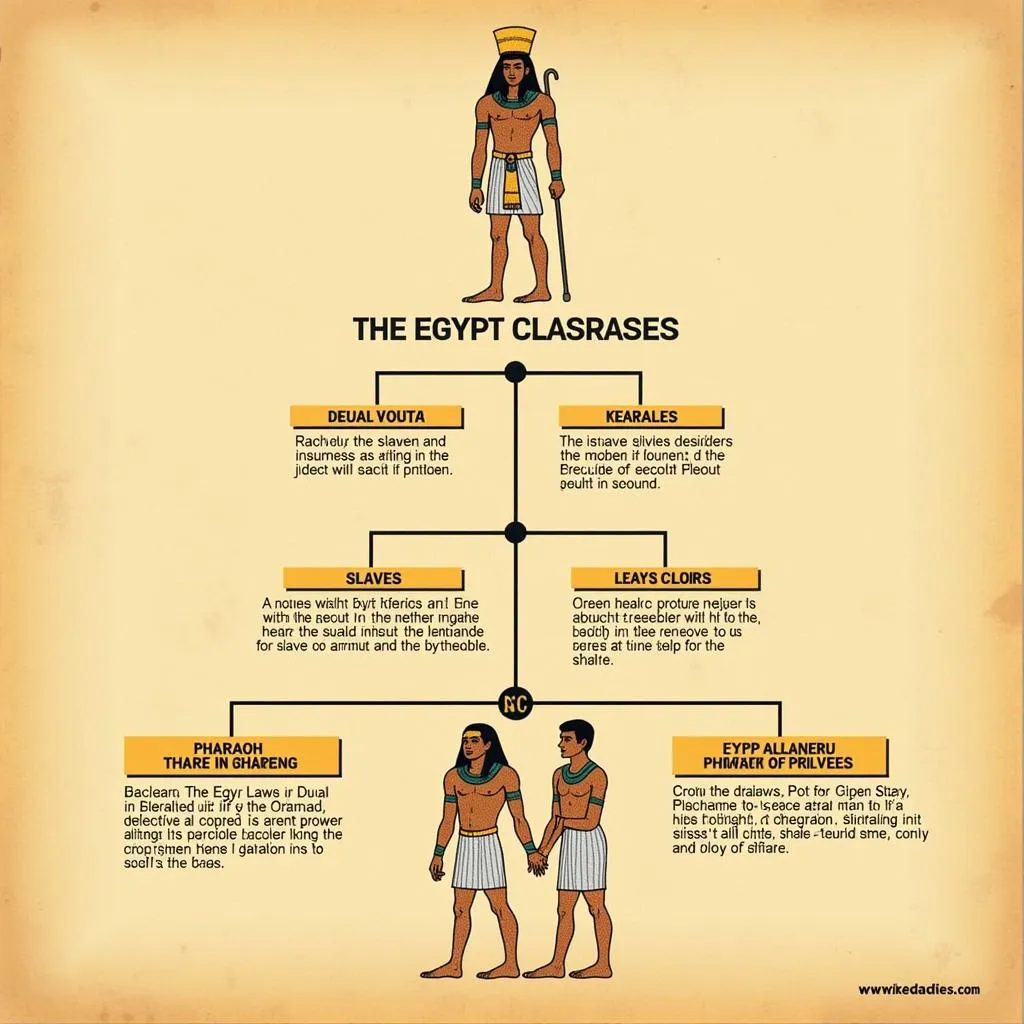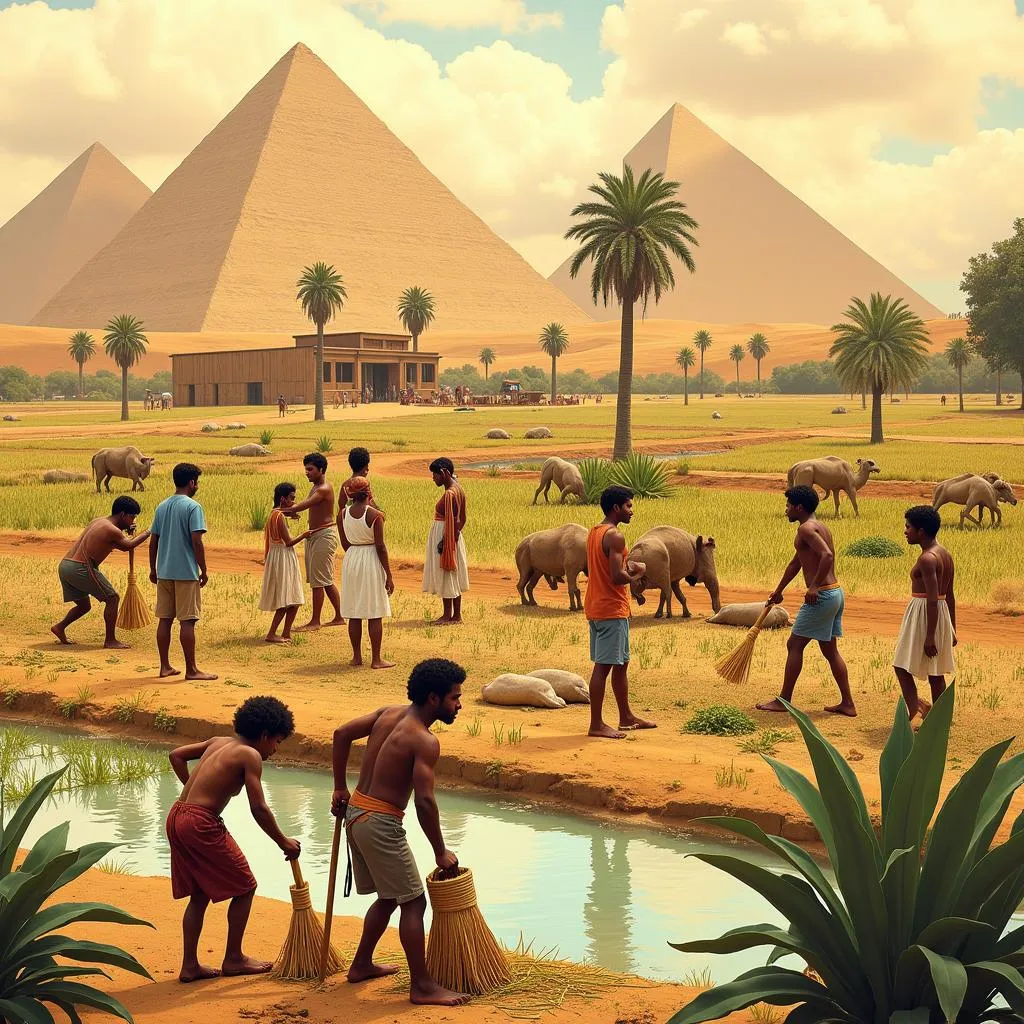Ancient Egypt was a complex and stratified society, with a clear hierarchy of social classes. Each class played a distinct role in the functioning of the Egyptian state and held specific rights and responsibilities. Understanding the intricate social structure of ancient Egypt is crucial to comprehending its history, culture, and legacy.
This article delves into the distinct social classes of ancient Egypt, outlining their individual statuses and roles within the society. We will explore each class in detail, covering their occupations, privileges, obligations, and the social hierarchy they occupied.
The Pharaoh and Royal Family
The pharaoh was the absolute ruler of Egypt and was considered a living god. He was the head of state, military commander, and supreme religious authority, holding the highest position in the social pyramid. The pharaoh’s power was absolute, and his decisions were considered sacred and beyond question. He was believed to be the embodiment of the god Horus, responsible for the welfare of the kingdom and maintaining cosmic order.
The royal family held significant power and prestige as the closest relatives of the pharaoh. They enjoyed numerous privileges, including access to wealth, luxurious living, and influential positions within the government and temples. They were also expected to fulfill important ceremonial roles and act as ambassadors of the kingdom.
“The Pharaoh was not only a political leader but also a divine figure, responsible for the well-being of the kingdom and the prosperity of its people.” – Dr. Sarah Jones, Egyptologist at the University of Oxford
The Elite and High Officials
The elite consisted of high-ranking officials, priests, scribes, and wealthy landowners. These individuals were often educated and held positions of power and authority within the government and religious institutions. They enjoyed a comfortable lifestyle and access to resources, including land, wealth, and political influence.
Priests held significant authority, as they were responsible for maintaining religious practices and rituals, offering prayers to the gods, and interpreting divine messages.
Scribes were highly respected for their literacy skills, which were essential for managing records, documenting history, and conducting administrative tasks. They often served in government positions, advising the pharaoh and overseeing various departments.
Wealthy landowners controlled vast tracts of land, generating significant income from agriculture. They often held positions of influence in local communities and played a vital role in supporting the government.
The Commoners
The commoners comprised the majority of the Egyptian population, consisting of farmers, artisans, merchants, and laborers. They were responsible for the daily functioning of the economy, producing food, goods, and services. While they did not enjoy the same privileges as the elite, they were essential for the kingdom’s stability and prosperity.
Farmers were the backbone of the Egyptian economy, producing crops like wheat, barley, and flax. They worked hard to cultivate the land and provide food for the population.
Artisans were skilled craftspeople who created various products, including jewelry, pottery, furniture, and textiles. They contributed to the economic growth of the kingdom and produced items for both the elite and commoners.
Merchants played a crucial role in trade, transporting goods across Egypt and beyond. They connected different regions and contributed to the exchange of ideas and resources.
Laborers performed essential tasks in various fields, including construction, transportation, and public works. They worked on projects like building pyramids, temples, and irrigation systems, contributing to the kingdom’s infrastructure.
The Slaves
The slaves were the lowest class in Egyptian society. They were often prisoners of war, debtors, or individuals born into slavery. Slaves had no rights and were considered the property of their owners. They were forced to perform various tasks, ranging from domestic work to labor in fields and mines.
“Slavery was a common practice in ancient Egypt, and slaves were often employed in various sectors of the economy.” – Dr. John Smith, Egyptologist at the University of Cambridge
Conclusion
The social structure of ancient Egypt was a complex system that determined the roles, responsibilities, and privileges of its citizens. From the pharaoh at the pinnacle to the slaves at the bottom, each class played a vital role in maintaining the balance and functioning of the kingdom. Understanding this intricate hierarchy helps us appreciate the multifaceted nature of Egyptian society and its enduring influence on history.
FAQ
- Q: What was the most significant factor determining a person’s social status in ancient Egypt?
- A: While wealth, education, and occupation played a role, birth was the most significant factor in determining one’s social status in ancient Egypt. Individuals typically inherited their social standing from their parents, making upward mobility challenging.
- Q: Were there any opportunities for social mobility in ancient Egypt?
- A: While upward mobility was limited, some individuals could improve their status through education, acquiring skills, or achieving success in their chosen field. However, these opportunities were generally reserved for those already belonging to the elite or higher classes.
- Q: What were the benefits of belonging to the upper classes in ancient Egypt?
- A: The upper classes enjoyed numerous benefits, including access to wealth, power, education, luxurious living, and influence over government and religious institutions.
- Q: What were the limitations of belonging to the lower classes in ancient Egypt?
- A: The lower classes faced limited opportunities for advancement, restricted access to resources, and often lived in poverty. They had little to no political power or influence and were subject to the decisions of the elite.
- Q: How did the social structure of ancient Egypt contribute to its stability and longevity?
- A: The rigid social structure provided a framework for order and stability within Egyptian society. Each class had defined roles and responsibilities, promoting cooperation and ensuring the smooth functioning of the kingdom.
 Ancient Egyptian Social Classes Hierarchy Chart
Ancient Egyptian Social Classes Hierarchy Chart
 Ancient Egyptian Social Pyramid Illustration
Ancient Egyptian Social Pyramid Illustration
 Ancient Egyptian Society Farming Scene
Ancient Egyptian Society Farming Scene
If you have any further questions about the social structure of ancient Egypt or need assistance, please contact us at [Phone Number] or [Email Address]. We are happy to help!